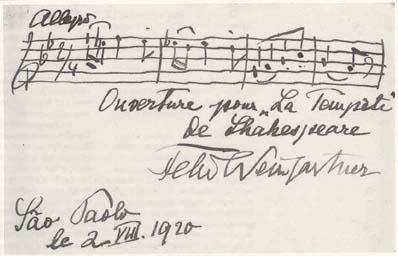
6
1. FRANCISCO BRAGA (1868-1945), compositor e regente brasileiro.
2. EDOUARD COLONNE (1838-1910), regente e violinista francês. C.p. autografado, Paris, 1904.
3. GINO MARINUZZI (1882-1943), regente e compositor italiano. Autógrafo e inscrição musical, Rio, 1921.
4. EDWARD NAPRAVINIK (1839-1916), compositor e regente tcheco, radicado na Rússia. Autógrafo e inscrição musical: "Lullaby from the opera Harold", São Petersburgo, 1907.
5. CLEOFONTE CAMPANINI (1860-1919), regente italiano. Fot.L.Ricci, Milão. Ed.G.Ricordi & C.
6. FELIX WEINGARTNER (1863-1942), compositor e regente austríaco, naturalizado Suíço. Autógrafo e inscrição musical.
7. SIR HENRY WOOD (1869-1944), regente inglês. Fot.Histed (Londres) C.p. autografado (1915).
8. SIR LANDON RONALD (1873-1938), compositor e regente inglês. Fot.Dover St.Studios. C.p. autografado (1915).
9. FREDERIC CORDER (1852-1932), compositor e regente inglês. C.p. autografado.
10. STEWART MACPHERSON (1865-1941), compositor inglês.
11. FRITZ REINER (1888-1963), regente húngaro.
12. HEITOR VILLA-LOBOS (1887-1959), compositor e regente brasileiro. C.p.autografado e com inscrição musical: '2ª Sinfonia", Rio, 1941.
13. SIR MALCON SARGENT (1895-1967), regente inglês.
14. SIR JOHN BARBIROLLI 91899-1970), regente inglês.
15. PIERO COPPOLA (1888-1971), compositor e regente italiano.
16. EUGEN SZENKAR (1891-1977), regente húngaro. C.p. autografado, Rio, 1939.
REGENTES
Além
de duas grandes personalidades brasileiras, o maestro Francisco Braga,
o primeiro regente que atuou no Teatro Municipal do Rio de Janeiro, e
Heitor Villa-Lobos, nosso maior compositor deste século, encontram-se
representados nesse painel muitos dos mais famosos regentes que atuaram
em importantes teatros do mundo.
Como Arturo Toscanini
(Painel 12, c.13), que teve inclusive sua estréia imprevista aos
19 anos de idade, como maestro, no Imperial Teatro D.Pedro II do Rio de
Janeiro, alguns desses eminentes nomes estrangeiros da regência
musical também se apresentaram no Brasil. Edouard Colonne, violinista
e regente francês, que seria lembrado pelos seus célebres
Concertos do Chatelet, que em Paris ainda levam seu nome, regeu no Brasil
em 1872 e mereceu do Imperador D.Pedro II o grau de Cavaleiro da Ordem
da Rosa. Cleofonte Campanini que regeria em Milão as estréias
das óperas Adrienne Lecouvreur (1902), de Cilea, e Madame Butterfly
(1904), de Puccini, dirigiu a orquestra da Companhia Lírica Ferrari
no Rio e em São Paulo em 1893, durante uma das longas tournées
da Companhia italiana pela América do Sul. Pietro Mascagni (P.27,
c.9), o grande compositor, regeu toda a temporada lírica de 1911
do Teatro Municipal do Rio de Janeiro, retornando ao Teatro em 1922. Gino
Marinuzzi estreou no Teatro Municipal em 1912 e voltou em sucessivas temporadas,
Felix Weingartner veio em 1920 e em 1922, quando regeu o ciclo completo
do Anel dos Nibelungos, a tetralogia de Wagner: O Ouro do Reno, A Valquíria,
Siegfried e O Crepúsculo dos Deuses. Posteriormente, ainda outros
regentes apresentados no painel, atuaram no Brasil.
CONDUCTORS
Besides
two great Brazilian personalities, maestro Francisco Braga, the first
conductor o present himself at the Municipal Theatre of Rio de Janeiro,
and Heitor Villa-Lobos, our greatest composer of this century, many other
conductors who performed in the most important theatres of the world are
represented in this panel.
As did Arturo Toscanini
(Panel 12, C.13), who gave his unexpected premiere as a conductor at the
age of 19 at the Imperial Theatre D.Pedro II of Rio de Janeiro, some of
these distinguished foreign names of International orchestra leaders also
performed in Brazil. Edouard Colone, a French violinist and conductor,
who would be remembered for his Chatelet Concerts, which still carry his
name, in Paris, conducted in Brazil in 1872, and was knighted by Emperor
Pedro II nd. with the Order of the Rose. Cleofonte Campanini who would
lead the orchestra in the opening of Adrienne Lecouvreur (1902), by Cilea,
and Madame Butterfly (1904) by Puccini, conducted the orchestra of the
Ferrari Lyrical Company in Rio and in São Paulo in 1893, during
one of the long tours of the Italian Company through South America. The
great composer Pietro Mascagni (P.27, C.9), was the conductor during the
entire lyrical season at the Municipal Theatre of Rio de Janeiro in 1911,
and returned once more to the same theatre in 1922. Gino Marinuzzi made
his debut at the Municipal Theatre in 1912 and came back in successive
seasons. Felix Weingartner came in 1920 and in 1922, when he conducted
the complete cycle of the Niebelung Ring: The Rhinegold, The Walkirie,
Siegfield and the Dusck of the gods. At later dates other conductors also
presented in this panel also performed in Brazil.